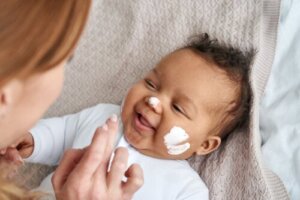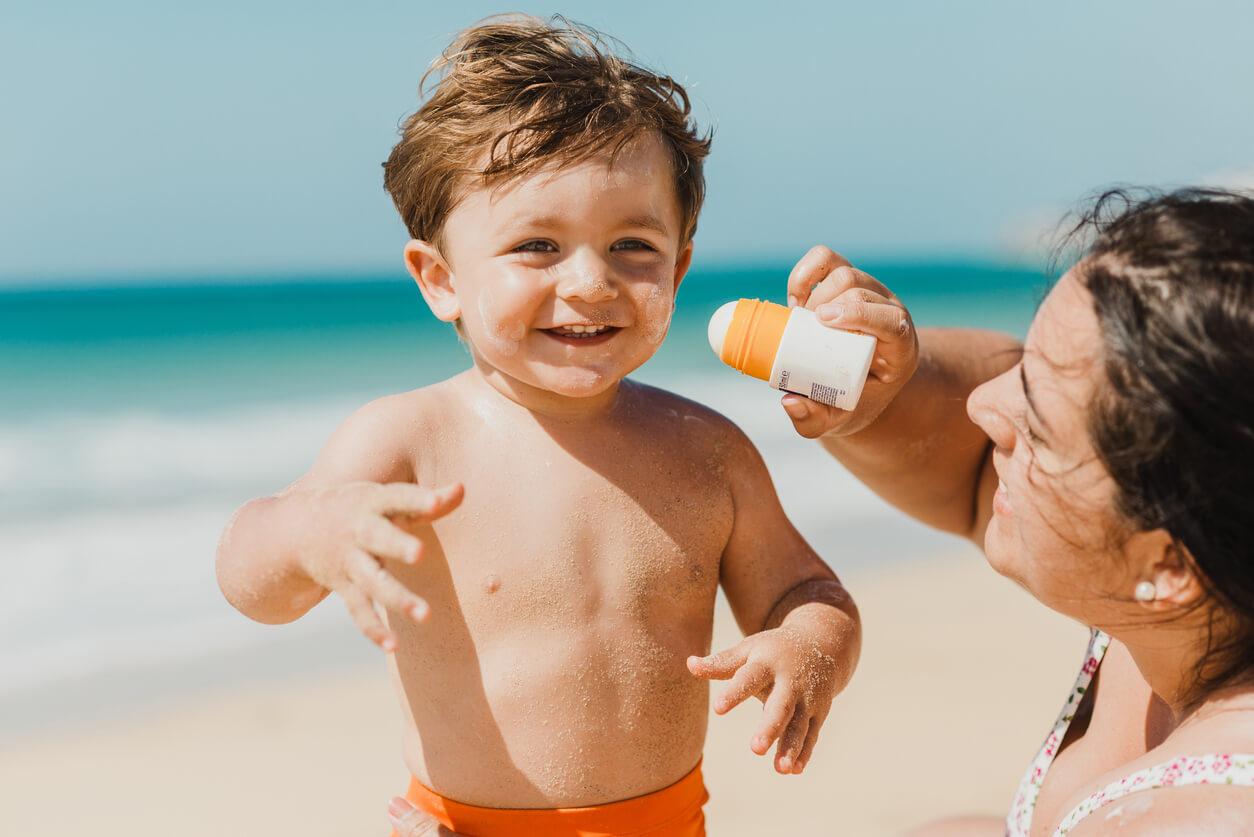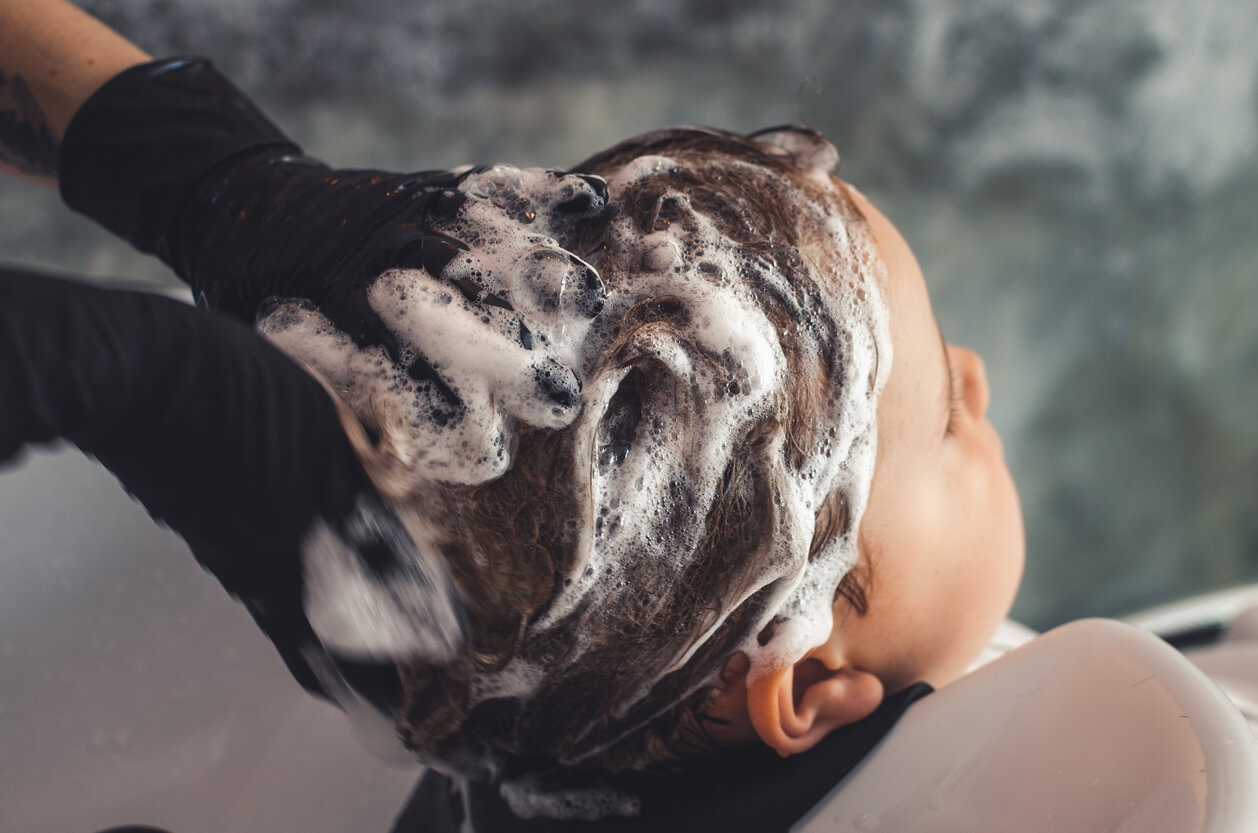Cosmetic Products for Children: Essential Skincare Products for Your Kid


Written and verified by the dermatologist Maria del Carmen Hernandez
Children’s delicate skin
The structural and functional maturation of the skin is a process that begins at birth and ends in the first year of life. Some of the vital functions of the skin include the following:
- Preventing invasion by pathogens
- Providing UV protection
- Regulating sensory perception
- Regulating body temperature
At birth, the skin is dry and rough. However, during the first three months, skin surface hydration increases and exceeds the level of hydration found in adults. The pH levels are higher than those of adult skin, which is usually between 5 and 5.5. In addition, the skin surface is full of host defense proteins at lower levels than in adults.
Always choose quality products
Children’s skin care requires certain considerations. In fact, maintaining a proper skincare routine contributes to healthy and soft skin. Some components of cosmetic products for children may irritate sensitive skin or be absorbed more quickly and easily by children’s thin skin surface. While each case is unique, it’s important to avoid those that may cause allergies or dermatitis.
You may be interested in: 10 Skincare Tips for Babies and Children

These are the essential cosmetic products for children
The younger a child is, the more sensitive their skin tends to be. Therefore, it’s more susceptible to irritants than adults and it’s common for them to develop irritations or allergies to common synthetic components.
Diaper cream
The creams used when changing your baby’s diaper are used to counteract skin conditions such as redness, dermatitis, or irritation. In addition, they have protective and soothing properties, as they create a barrier between the diaper and the skin.
Their soothing and moisturizing properties are due to one of their main components, zinc oxide. There are also some that contain calendula, chamomile, vegetable oils, fats, and shea butter. It’s always best to avoid using products that contain allergenic fragrances or preservatives such as methylisothiazone.
Facial sunscreen: One of the most important cosmetic products for children
Sunscreen isn’t recommended for babies under 6 months of age. However, in children, it should be applied on the face and areas of the skin that are exposed. When choosing a sunscreen, it’s best to opt for mineral-based formulas, that is, physical sunscreens that block ultraviolet rays.
According to the recommendations of the American Academy of Dermatology Association, sunscreens composed of titanium dioxide or zinc oxide are ideal to reduce the possibility of skin irritation.
Read also: Chemical or Mineral Sunscreens: Which Are Better for Children?
Scalp-friendly shampoo
Shampoos are used to cleanse the scalp of environmental pollutants and dirt. Children’s scalps produce less sebum than adults, so a product with fewer detergents is ideal.

Dermis-friendly gel
Many cleansing products remove the natural oils from the skin’s surface, which makes it difficult for the child’s skin to maintain its moisture at the correct levels. Cleansing gel should be mild and free of dyes or synthetics. According to a publication in Dermatology Research and Practice, the ideal cleansing gel prevents impurities and oils from mixing with water and helps remove bacteria and dirt.
Children’s sunscreen
Always choose physical sunscreens over chemical ones to help avoid products that are harmful or irritants that are absorbed directly into the skin. Sunscreen should be broad spectrum and reapplication is indicated every 2 hours for continued exposure to ultraviolet rays.
Children’s cosmetics and skin care
By implementing a daily skincare routine, parents help develop an even stronger skin barrier as children get older. This should include a gentle cleansing gel, a moisturizer without harmful chemicals, and adequate sun protection.
It’s important to note that cosmetic products for children don’t have to be the most expensive on the market. In fact, there are many inexpensive variants that are equally effective and safe.
Children’s delicate skin
The structural and functional maturation of the skin is a process that begins at birth and ends in the first year of life. Some of the vital functions of the skin include the following:
- Preventing invasion by pathogens
- Providing UV protection
- Regulating sensory perception
- Regulating body temperature
At birth, the skin is dry and rough. However, during the first three months, skin surface hydration increases and exceeds the level of hydration found in adults. The pH levels are higher than those of adult skin, which is usually between 5 and 5.5. In addition, the skin surface is full of host defense proteins at lower levels than in adults.
Always choose quality products
Children’s skin care requires certain considerations. In fact, maintaining a proper skincare routine contributes to healthy and soft skin. Some components of cosmetic products for children may irritate sensitive skin or be absorbed more quickly and easily by children’s thin skin surface. While each case is unique, it’s important to avoid those that may cause allergies or dermatitis.
You may be interested in: 10 Skincare Tips for Babies and Children

These are the essential cosmetic products for children
The younger a child is, the more sensitive their skin tends to be. Therefore, it’s more susceptible to irritants than adults and it’s common for them to develop irritations or allergies to common synthetic components.
Diaper cream
The creams used when changing your baby’s diaper are used to counteract skin conditions such as redness, dermatitis, or irritation. In addition, they have protective and soothing properties, as they create a barrier between the diaper and the skin.
Their soothing and moisturizing properties are due to one of their main components, zinc oxide. There are also some that contain calendula, chamomile, vegetable oils, fats, and shea butter. It’s always best to avoid using products that contain allergenic fragrances or preservatives such as methylisothiazone.
Facial sunscreen: One of the most important cosmetic products for children
Sunscreen isn’t recommended for babies under 6 months of age. However, in children, it should be applied on the face and areas of the skin that are exposed. When choosing a sunscreen, it’s best to opt for mineral-based formulas, that is, physical sunscreens that block ultraviolet rays.
According to the recommendations of the American Academy of Dermatology Association, sunscreens composed of titanium dioxide or zinc oxide are ideal to reduce the possibility of skin irritation.
Read also: Chemical or Mineral Sunscreens: Which Are Better for Children?
Scalp-friendly shampoo
Shampoos are used to cleanse the scalp of environmental pollutants and dirt. Children’s scalps produce less sebum than adults, so a product with fewer detergents is ideal.

Dermis-friendly gel
Many cleansing products remove the natural oils from the skin’s surface, which makes it difficult for the child’s skin to maintain its moisture at the correct levels. Cleansing gel should be mild and free of dyes or synthetics. According to a publication in Dermatology Research and Practice, the ideal cleansing gel prevents impurities and oils from mixing with water and helps remove bacteria and dirt.
Children’s sunscreen
Always choose physical sunscreens over chemical ones to help avoid products that are harmful or irritants that are absorbed directly into the skin. Sunscreen should be broad spectrum and reapplication is indicated every 2 hours for continued exposure to ultraviolet rays.
Children’s cosmetics and skin care
By implementing a daily skincare routine, parents help develop an even stronger skin barrier as children get older. This should include a gentle cleansing gel, a moisturizer without harmful chemicals, and adequate sun protection.
It’s important to note that cosmetic products for children don’t have to be the most expensive on the market. In fact, there are many inexpensive variants that are equally effective and safe.
All cited sources were thoroughly reviewed by our team to ensure their quality, reliability, currency, and validity. The bibliography of this article was considered reliable and of academic or scientific accuracy.
- Castelo-Soccio L, McMahon P. Pediatric Dermatology. J Clin Aesthet Dermatol. 2017;10(3):S8-S15.
- Telofski LS, Morello AP 3rd, Mack Correa MC, Stamatas GN. La barrera cutánea infantil: ¿podemos preservar, proteger y mejorar la barrera ?. Dermatol Res Pract . 2012; 2012: 198789. doi: 10.1155 / 2012/198789
- Fernandes JD, Machado MC, Oliveira ZN. Children and newborn skin care and prevention. An Bras Dermatol. 2011 Jan-Feb;86(1):102-10. English, Portuguese. doi: 10.1590/s0365-05962011000100014. PMID: 21437530.
- Lawton S. Understanding skin care and skin barrier function in infants. Nurs Child Young People. 2013 Sep;25(7):28-33; quiz 34. doi: 10.7748/ncyp2013.09.25.7.28.e358. PMID: 24021151.
- Truhan AP. Sun protection in childhood. Clin Pediatr (Phila). 1991 Dec;30(12):676-81. doi: 10.1177/000992289103001205. PMID: 1764876.
- Baldwin S, Odio MR, Haines SL, O’Connor RJ, Englehart JS, Lane AT. Skin benefits from continuous topical administration of a zinc oxide/petrolatum formulation by a novel disposable diaper. J Eur Acad Dermatol Venereol. 2001 Sep;15 Suppl 1:5-11. doi: 10.1046/j.0926-9959.2001.00002.x. PMID: 11720074.
This text is provided for informational purposes only and does not replace consultation with a professional. If in doubt, consult your specialist.








